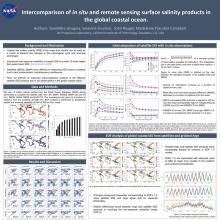Intercomparison of in situ and remote sensing surface salinity products in the global coastal ocean.
Sreelekha
Jarugula
Jet Propulsion Laboratory
Poster
Observing coastal ocean salinity is crucial for understanding the physical and biological processes impacting ocean circulation, ecosystems and the hydrological cycle. We perform a thorough comparison between in situ and satellite sea surface salinity (SSS) products with a focus on global coastal ocean. In the vicinity of 40-500 km from the coastline, we intercompare SSS from more than two million World Ocean Database (WOD) salinity profiles, gridded Argo data and satellite products: NASA Multi-Mission Optimally Interpolated Sea Surface Salinity (OISSS), 40 and 70-km Remote Sensing Systems (REMSS) Soil Moisture Active Passive (SMAP), Jet Propulsion Laboratory (JPL) SMAP, Laboratory of Oceanography and Climate: Experiments and Numerical Approaches (LOCEAN) Soil Moisture Ocean Salinity (SMOS) and European Space Agency (ESA) Climate Change Initiative (CCI) salinity. We find good agreement between the satellite products and in situ data with satellite-in situ mean differences (0.5-1.7 pss), root-mean-square differences (0.5-2.4 pss) and signal-to-noise ratios (1-3.8) generally decreasing exponentially from 40-100 km distance to the coast and remaining constant past 100 km. Empirical orthogonal function (EOF) analysis shows that all the satellite and in situ SSS compare well in capturing modes-1 and 2 seasonal variability but have notable differences in the amplitude of the mode-3 non-seasonal variability in coastal SSS. This study has implications for validation and improvement of satellite SSS and emphasizes the need for designing future satellite missions to better resolve the coastal salinity.

Poster file
jarugula-sreelekha-poster.pdf
(1.04 MB)
